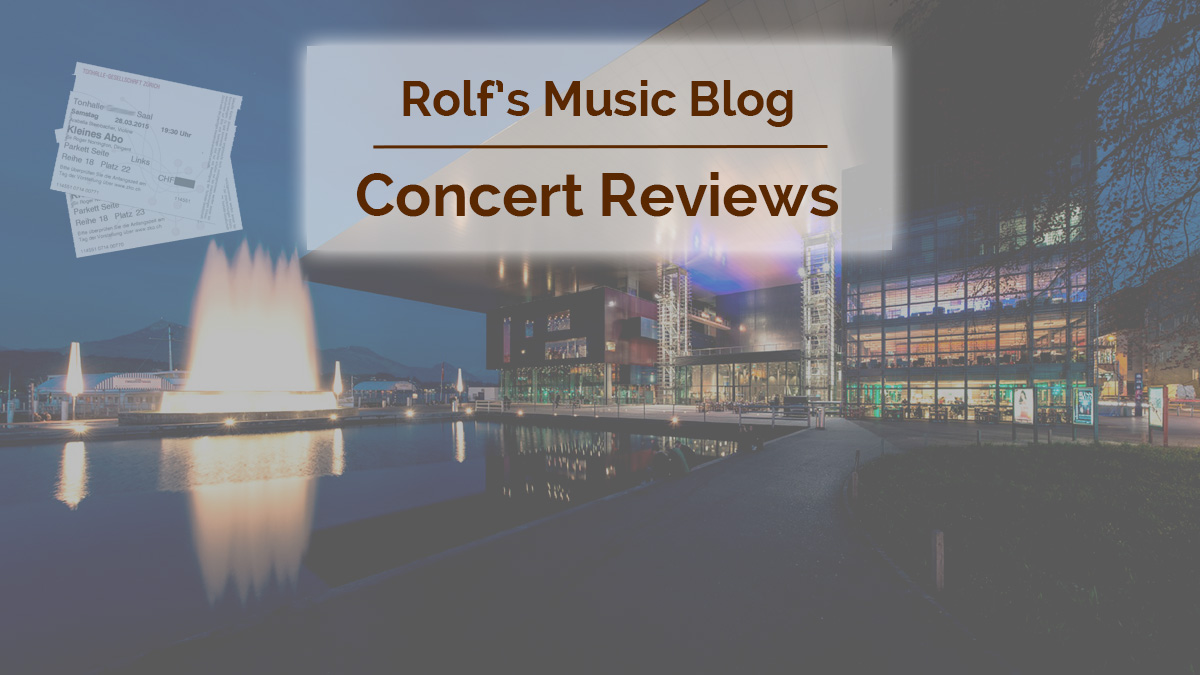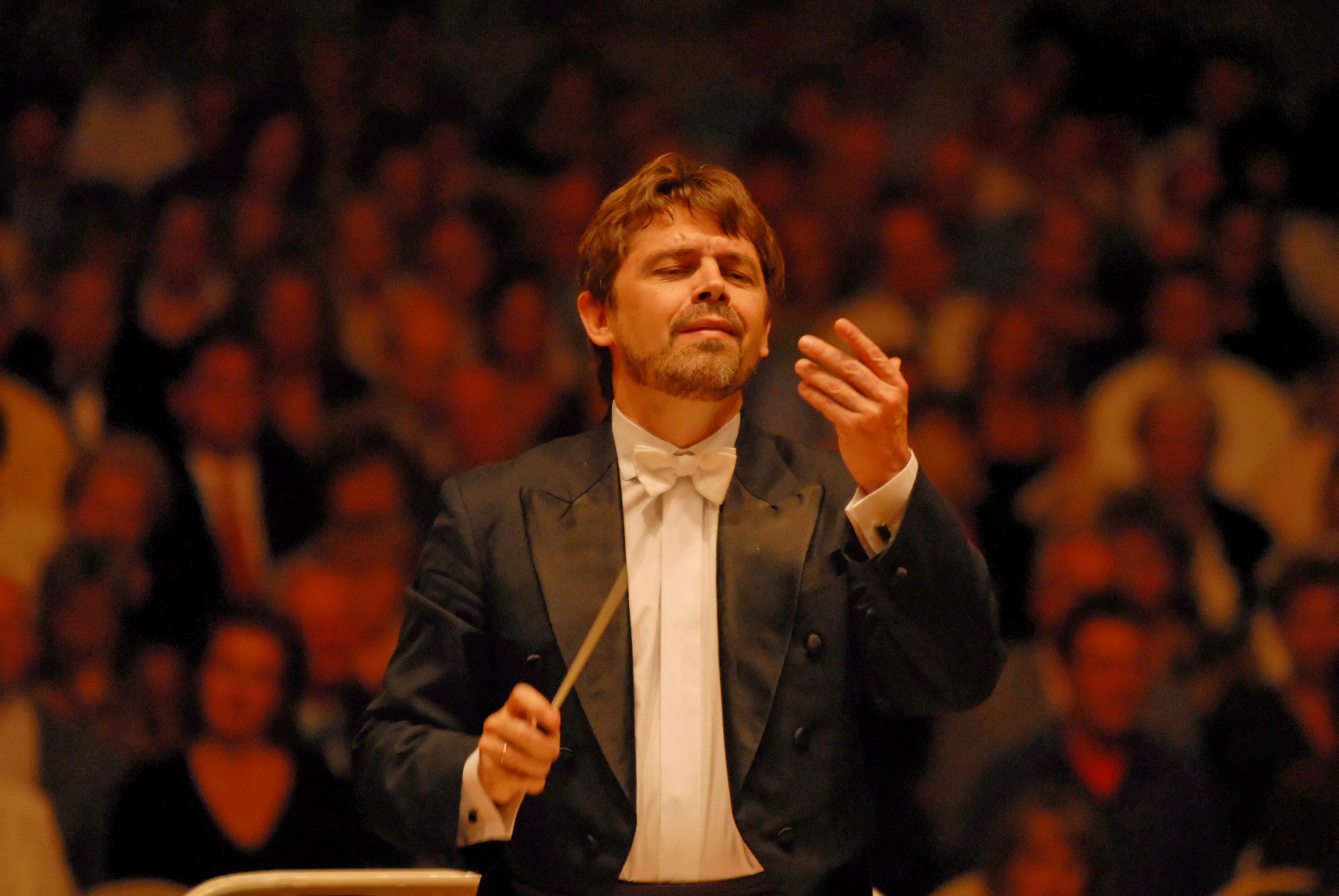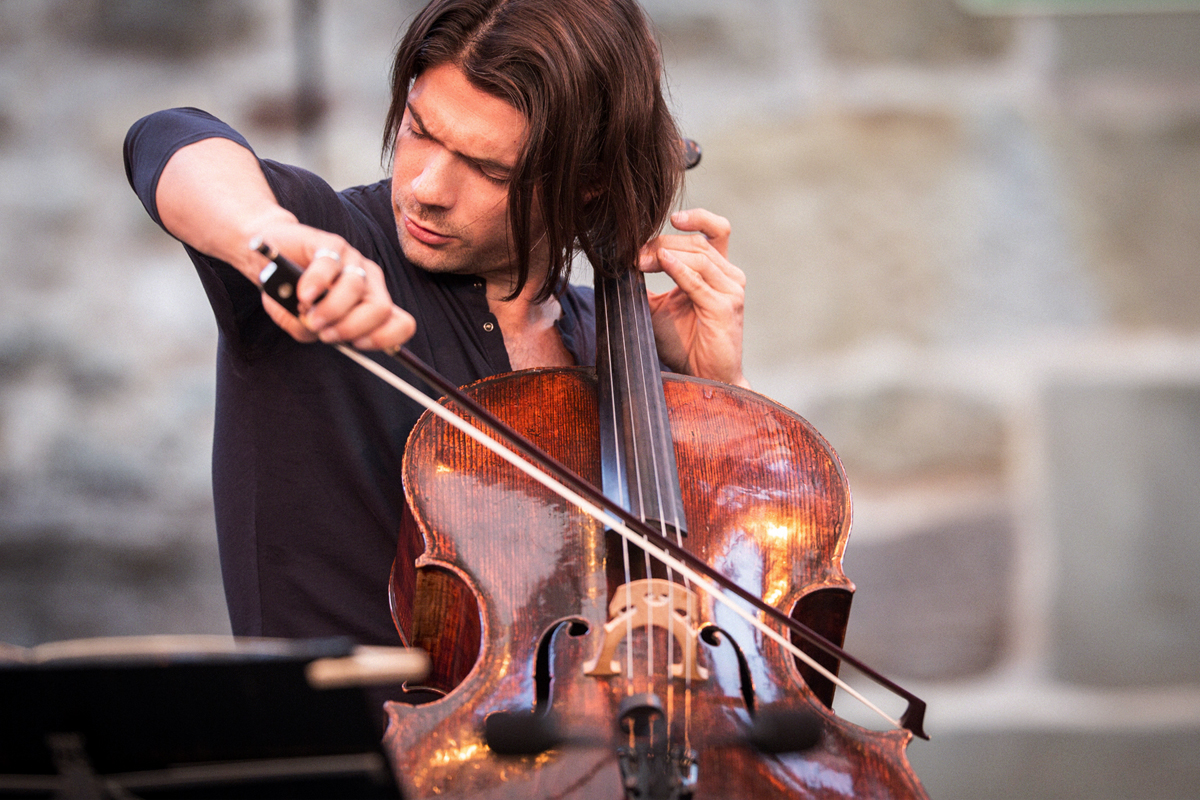Gautier Capuçon, Andrey Boreyko
Respighi, Bloch, Dvořák
KKL Lucerne, 2016-01-13

2016-01-18 — Original posting
2016-09-16 — Brushed up for better readability
Table of Contents
The Orchestra
Back to the KKL (Culture and Convention Center Lucerne) for an orchestral concert. This time, it was my first encounter with the Lucerne Symphony Orchestra (Luzerner Sinfonieorchester). Apparently, this is the oldest symphony orchestra in Switzerland. Its predecessor organization, the Allgemeine Musikgesellschaft Luzern (General Music Society of Lucerne) emerged in 1806. The orchestra is in the fortunate position to call the KKL its home venue. Since 2011, the principal conductor of the orchestra is James Gaffigan (*1979 in New York). Notable earlier chief conductors were Willem Mengelberg (1871 – 1951, conducting the orchestra 1892 – 1895) and Jonathan Nott (*1962, conducting here 1997 – 2002).
The Conductor: Andrey Boreyko
In this concert, the orchestra was led by guest conductor Andrey Boreyko, born 1957 in Saint Petersburg. Since 2012, Boreyko is director of the Orchestre National de Belgique, after holding positions in Jena, Hamburg, Berne, Düsseldorf. Since 201, Boreyko is also Music Director with the Naples Philharmonic Orchestra. He is pursuing an international conducting career, primarily in Western Europe and in North America. His first cooperation with the Lucerne Symphony Orchestra took place in 2011.
Ottorino Respighi: Suite “Belkis, Regina di Saba“
The legendary and biblical figure of King Solomon governed the first half of the concert. That figure appeared under two contrasting aspects. The evening started with the suite “Belkis, Regina di Saba” (Belkis, Queen of Sheba), which Ottorino Respighi (1879 – 1936) created 1934. The suite originates from Respighi’s music to a ballet with the same name. This ballet had been a complete failure: it survived 11 performances, but then disappeared entirely. Most likely, its concept was far too complex for a typical stage production. In trying to recover some of that material, Respighi planned on two suites, only the first of these he ever completed.
The ballet describes the visit of the Queen of Sheba to King Solomon, in a colorful, fascinating soundscape. Even just the excerpt from the ballet, this suite, is a composition that really isn’t played enough in concerts today. That’s maybe a reverberation from the failure of the original ballet?
The Movements
The suite features four movements:
- “Il sogno di Salomone” (Solomon’s dream)
- “La danza di Belkis all’aurora” (Belkis’ dance at dawn)
- “Danza guerresca” (War dance)
- “Danza orgiastica” (Orgiastic dance)
Instrumentation
This concert (as typical other interpretations and recordings) swapped the sequence of the movements II and III. This leads to a more convenient slow—fast—slow—fast scheme. The composition asks for a very rich instrumentation:
- 13 woodwinds: 3 flutes (1 ottavino), 2 oboes, cor anglais, 4 clarinets (soprano in D & E♭, 2 x B♭, bass clarinets in A and B♭), 2 bassoons, contrabassoon
- 12 brass instruments: 4 horns, 4 trumpets, 4 trombones
- 8 percussion players: timpani, “Tamburo Arabo”, “Tamburo Basco”, “Tamburo Militare”, triangle, cymbals, tam-tam, big drum
- xylophone, bells, celesta, 2 harps, piano
- back-stage voice (tenor or trumpet), 3 trumpets (balcony), 2 “war drums”
- strings (Vl I / II, Vla, Vc, Cb)
The Performance
I. “Il sogno di Salomone“
The movement “Il Sogno di Salomone” begins slowly, pianissimo, with dark string colors accompanying woodwind instruments that create a peculiar, dreamy atmosphere, supported by harps and celesta. Right from the first bars, the excellent acoustics of the “white” hall in the KKL (the event was fairly well-sold) were very obvious. All of the wind instruments (excellent throughout!) could be easily and clearly located, they sounded clear and well-articulated. The room carries the music from the faintest pianissimo up to the full strength of the orchestra, even in this very rich instrumentation, and across the entire tonal range, from the warm-sounding basses up to the highest and faintest silvery tones from the celesta: pure acoustic joy and pleasure!
On Seating in the KKL
As a little aside: the “white” hall is said not to have any bad seats. I was sitting pretty much in the center of the audience (parquet seat). My neighbors were regular concert goers who always occupy the two seats they are subscribed to. They were raving about the amount of detail that one could hear in this hall. But they told me that they were once sitting in the back of the top balcony. Indeed, the sound was excellent there, too—perfect even, “like a CD recording”. Though, of course, from that distance, the impression is far more “polished”. It lacks the detail that one can observe & hear from close-up, and it probably also covers up one or the other “unwanted feature” from the performance…
In this “dream movement”, the music builds up to almost pompous scenes, sometimes with compact, dense sound. Yet, it remains transparent and differentiated in the sound impression. The piece was performed with well-controlled dynamics. Especially in louder passages I liked the dense, homogeneous string sound, the solid foundation from the double basses and cellos. At the same time, the beautifully vocal melody line of the solo cello stood out and projected well, even though it remained embedded in the orchestral accompaniment. The one minor reservation I have is that the violins were sometimes playing so softly that they were hard to hear.
III. “Danza guerresca“
The next movement we heard was the short and martial “Danza guerresca“, allowing the brass and percussion sections to excel, exhibiting agility, rhythmic firmness., In-between, the listeners had fun listening to the joking caricature part played by the soprano clarinet in D.
II. “La danza di Belkis all’aurora“
In some parts, the movement “La danza di Belkis all’aurora” vaguely reminded me of Maurice Ravel’s “Boléro” (without the drum ostinato, though). At the same time, there were also moments that made me think of Claude Debussy’s “L’après-midi d’un faune“. Overall, I found it to be a masterpiece in instrumentation throughout, with enchanting impressionism when the celesta spreads its glittering star-dust. Above this “sound carpet”, atmospheric, meandering solo lines by flute, cor anglais, clarinet and the impressionist solo violin evoke a scenery with the dancing Queen of Sheba.
IV. “Danza orgiastica“
After an introductory unison, the fourth movement, “Danza orgiastica“, deploys a rich spectrum in sound colors. It was a true orchestral spectacle, enthralling, sometimes reminding me of Tchaikovsky’s Fifth Symphony. Throughout the piece, Andrey Boreyko kept the orchestral apparatus under control, avoiding too much exuberance. The “back-stage voice (tenor or trumpet)” was a distant trumpet, playing in a corridor to the organ balcony, far above the orchestra. The tuning for that instrument was maybe a tad low, in parts. That latter impression was not confirmed when the three trumpets played their fanfares from the organ balcony itself.
Ernest Bloch: Hebraic Rhapsody “Schelomo”
The concert continued with the Hebraic Rhapsody “Schelomo” (Solomon) for Violoncello Solo and Full Orchestra by Ernest Bloch (1880 – 1959). Bloch was born in Geneva, studied music theory, violin and composition. His first teacher in Geneva was Émile Jaques-Dalcroze. Capuçon continued his studies in Brussels (violin studies with Eugène Ysaÿe), in Frankfurt and in Munich. After failing with an opera in Paris, he returned to Switzerland, to teach in the conservatory in Geneva. 1916 he moved to the United States, where he spent the rest of his life. In that same year 1916, he composed “Schelomo“, in reaction to the consequences of WWI, which made him feel progressively depressed.
“Schelomo” depicts King Solomon as a pensive, sad and desperate, contemplating man, totally immersed in thoughts. The role of King Solomon is played by the solo cello. Bloch initially wrote this for voice. But then, he did not find a conclusive answer to the question which language to select. The solo now essentially remains a vocal role, the entire piece being a single, long recitative.
The very successful and popular French cellist Gautier Capuçon (*1981) was playing on a cello by Mattio Goffriller (1701). This is the ideal instrument to take this role, with its round, full, warm sound. It was very well carried, if not enhanced by the acoustics of the venue, miraculously projecting above the orchestral foundation, even in very low and soft passages.
The Performance
Despite a relatively strong (though not exceedingly nervous) vibrato, Gautier Capuçon played with clear intonation and clean articulation. It was particularly fascinating to hear how he could make the instrument grow out of the orchestra sound. The vibrato did not hurt at all in this music, given that the cello was playing its “natural role”, a substitute for the human voice in the center of the piece. Of course, its tonal range is far wider than that of the human voice, doing “sound painting”, mourning, lamenting. Gautier Capuçon was excellent in this part, his playing wonderful—though without showing off or really playing out the typical Jewish “folk tone”. At times, I wished for a more gradual, “dragged” transition between tones, a more vocal approach to playing intervals.
There is an interesting passage with an explicitly notated quarter-tone displacement at the beginning of the third part (Andante moderato). That quarter-tone note was barely noticeable, even if as a listener one expected it to happen. I suspect that Gautier Capuçon isn’t familiar enough with the Jewish idiom. Hence he may have preferred playing the “pure music as written in the score”. This avoids missing the proper folk tone and ultimately making it sound like an inappropriate caricature. His playing was vivid and engaged. At the same time, it was also pleasant to see him turn his head to participate (mentally and visibly) in orchestral intermezzos, too!
Antonín Dvořák: Symphony No.7 in D minor, op.70, B.141
The second part of the concert featured the Symphony No.7 in D minor, op.70, B.141 by Antonín Dvořák (1841 – 1904). Dvořák wrote this work 1884 – 1885, for an English audience. This was at a time when his career as a composer was at its peak. The London Philharmonic Society had elected Dvořák to be an honorary member and asked him to write a symphony. That composition reached completion in March 1885. It premiered on 1885-04-22. Later in the same year, Dvořák made some corrections. He also shortened the second movement by 40 bars. That is the way it finally appeared in print in autumn 1885.
In this concert, Dvořák’s music led into an entirely different sphere. At the same time, its harmonic language isn’t too far from that of the preceding compositions. The symphony features four movements:
- Allegro maestoso, 6/8 (3/8=66)
- Poco adagio, 4/4 (1/4=56)
- Scherzo: Vivace, 6/4 (3/4=80) — Poco meno mosso — Vivace
- Finale: Allegro, 2/2 (1/2=100)
The Performance
I. Allegro maestoso
Andrey Boreyko (who exhibited a jovial, sporty attitude throughout the concert) started the symphony in a fluent pace. I found it to be more Allegro than maestoso. It was elegant, and focusing more on melody lines and phrasing than on details in articulation. This may have been superficial in the “small print”, but at least it avoided disrupting the flow, losing the momentum. Dvořák’s instrumentation features 2 flutes/piccolo, 2 oboes, 2 clarinets, 2 bassoons, 4 horns, 2 trumpets, 3 trombones, drums, and strings. It is considerably slimmer than that of Respighi’s and Bloch’s compositions in this concert. This caused the violins to be more exposed. In contrast to the Respighi piece, the violins now sounded less homogeneous, even a bit thin in soft passages.
II. Poco adagio
The second movement, Poco adagio, was distinctly slow (much slower than Dvořák’s annotation), atmospheric, but never overblown. I found the interpretation to retain attention to detail, to be careful (e.g., the pizzicati), with controlled dynamics. Within the wind instruments, I particularly liked the excellent horn playing.
III. Scherzo: Vivace — Poco meno mosso — Vivace
The Scherzo is a vibrant movement with a light appearance. Technically, it is not without challenges. Boreyko chose a pace that left room for details in articulation and dynamics, and the light playing helped maintaining transparency. Here, the violins sounded distinctly better again, their playing clear and homogeneous. Particularly in this movement (but also in this composition in general), I found the interpretation of Dvořák’s symphony by Andrey Boreyko to be rather instrumental than atmospheric. I missed the Slavonic temperament that is so characteristic of most of that composer’s music.
IV. Finale: Allegro
My reservations about the Scherzo also apply to the final movement (Allegro). Again, I found the interpretation more technical than “Slavonic”. There was good work on details. Boreyko maintained the flow quite well, the music had momentum. Sadly, the orchestra arrangement had the two violin voices on the left (Vl.I—Vl.II—Vla—Vc). This defeated the “echo / stereo effects”, i.e., the mutual responding between the two violin voices, particularly in this movement. But of course, an arrangement with the two violin voices on either side of the podium is substantially more demanding on the internal coordination between the two violin voices—and in this movement, the violins sounded more exposed again!
Conclusion
Overall, the Lucerne Symphony Orchestra presented itself in excellent shape (really with just minor exceptions), in a very respectable performance. Andrey Boreyko appeared to conduct the ensemble with firm hand. Also, the orchestra was well-prepared for the concert. My main reservations are about the interpretation, not the performance. All in all, I found this to be an interesting, enriching concert experience. I’m looking forward to hearing the ensemble again in future concerts!
Addendum
For the same concert, I have also written a (much shorter) review in German for Bachtrack.com. This posting is not a translation of that German review, the rights of which remain with Bachtrack. I create the German review using a subset of the notes taken during this concert. I wanted to enable my non-German speaking readers to read about my concert experience as well. Therefore, I have taken my original notes as a loose basis for this separate posting. I’m including additional material that is not present in the Bachtrack review.



